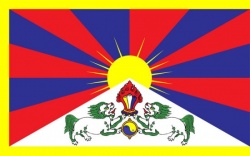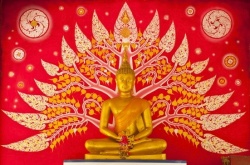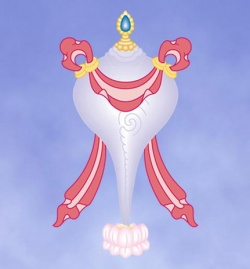Difference between revisions of "Flag of Tibet"
| (One intermediate revision by the same user not shown) | |||
| Line 1: | Line 1: | ||
| − | + | [[File:Tibetan-flag-550x344.jpg|thumb|250px|]]<nomobile>{{DisplayImages|677|1682|3528}}</nomobile> | |
| − | |||
| − | [[File:Tibetan-flag-550x344.jpg|thumb|250px|]] | ||
| Line 56: | Line 54: | ||
{{W}} | {{W}} | ||
[[Category:Tibet]] | [[Category:Tibet]] | ||
| + | [[Category:The Tibetan national flag]] | ||
Latest revision as of 18:03, 9 August 2019
The Tibetan flag, also known as the "snow lion flag", was a flag of the military of Tibet, introduced by the 13th Dalai Lama in 1912 and used as a national flag until 1959.
Designed with the help of a Japanese priest, it reflects the design motif of the Japanese military's Rising Sun Flag. Since the 1960s, it is used a symbol of the Tibetan independence movement[
History
Design and early use
In the early 20th century, after the fall of the Qing Dynasty and the end of control over Tibet by Chinese central government, the Tibetan army received training from the British and Japanese and all army regiments were ordered to carry the Tibetan national flag.
According to the scholar Alexander Berzin,
in the face of a continuing Chinese military threat and lack of Russian or British support, Tibet turned to Japan to update the Tibetan army.... Aoki Bunkyo, a Japanese Buddhist priest...also helped design the Tibetan National Flag by adding to traditional Tibetan symbols a rising sun surrounded by rays. This motif comprised the Japanese cavalry and infantry flags of the day and later became the design for the Japanese Navy and Army Flag during World War II.
The snow lion motif was also used on a banner seen flying above a Tibetan government building during the 1917-1918 Sino-Tibetan War: “Over the Kalon Lama’s residence, a small Tibetan house, floats the banner of Tibet, a yellow flag bearing a device like a lion in green, with a white snow mountain and a sun and moon in the corner."
Beginning in 1928, images of the Tibetan flag were widely published by companies in Europe, North America, South America, the Middle East, and Oceania in national flag collections on various forms of trading cards.
The flag made its first official international appearance in an official British Crown publication in 1930, "Drawing of The Flags of All Nations." It was also featured in the National Geographic Magazine in their 1934 “Flags of the World” edition.
According to Tibetologist Melvyn C. Goldstein, The Dalai Lama's government in Tibet did not fly the flag on government buildings or on national holidays, and few members of the public knew what the flag looked like. This claim is contested by Tibetan writer Jamyang Norbu who points out that the flag can be seen in historic footage flying atop Lhasa's largest building at the foot of the Potala Palace.
Representatives of the Indian independence movement invited Tibetan delegates to the 1947 Asian Relations Conference in New Delhi, which hosted Asian states and Asian independence movements, and the delegates were allowed to display their flag. According to Tibetologist A. Tom Grunfeld, the conference was not government-sponsored, and so Tibet's and the Tibetan flag's presence had "no diplomatic significance". Nonetheless, the Republic of China, also present at the conference, protested Tibet's showing, and in response, the Tibetan flag was removed and conference organizers issued a statement that Jawaharlal Nehru invited the Tibetan delegates "in a personal capacity".
The flag continued to be used in the 1950s under the newly established People's Republic of China, although the flag's status was unclear.
Many in the Communist Party of China felt that the usage of the flag indicated separatism, but the Tibetan local government at the time stressed that the flag was an army flag (the Tibetan army continued to exist parallel to People's Liberation Army infantries) and not a national flag.
Phuntso Wangye claims that Mao Zedong discussed the flag in 1955 conversation with the 14th Dalai Lama.
According to the story, Mao told the Dalai Lama that Zhang Jingwu, Zhang Guohua, and Fan Ming told him that Tibet had a "national flag". The Dalai Lama replied that Tibet had an army flag. Supposedly Mao replied that "you may keep your national flag". There is no official recognition of this conversation in Chinese documents, though.
Even while it was used by the army, few Tibetans in Tibet knew about the 'snow lion flag, and so when they wanted to protest against the government, they would use a flag that imitated the flag of Chushi Gangdruk instead.
As a pro-independence symbol
After the 1959 Tibetan Rebellion, the 14th Dalai Lama left his position as governor of Tibet, denounced the 17-point agreement with the PRC, and established the exile Central Tibetan Administration in India.
As part of his project to inculcate pan-Tibetan nationalism (of all Tibetan people and not just those in his previous domain of the Tibet Autonomous Region), he standardized and adopted symbols as nationalist symbols, such as the Lhasa dialect of Tibetan, a Tibetan national anthem, and the flag.
According to the Central Tibetan Administration website, the symbolism of the flag includes the mountain representing Tibet, the snow lions of "a unified spiritual and secular life", three-coloured jewel of the Buddha, the Dharma and the Sangha.
The flag was adopted as a symbol of the Tibetan independence movement, and has become known as the "Free Tibet flag". Through the diaspora's and international protesters' use of the flag, it became known and used in protest by the Tibetan public. The flag is banned in mainland China.



